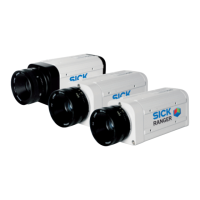Reference Manual Chapter 4
Ranger E/D
©SICK AG • Advanced Industrial Sensors • www.sick.com • All rights reserved 33
Ranger Studio
The parameter list is a table containing the parameter names and parameter values.
When selecting a parameter name, or its value, information about parameter type, range
etc is displayed in the status bar at the bottom. The value of a parameter can be changed
in the parameter value column.
The status bar at the bottom of the parameter editor displays additional information about
the selected parameter.
Value The value type of the parameter, for example int for integer.
Min The lower limit of the parameter.
Max The upper limit of the parameter.
Default The default value of the parameter.
Parameter type If the parameter is of type Argument, Setting or Property
Argument The camera needs to be stopped before changing
this parameter.
Setting This parameter can be changed at any time.
Property Read only parameter that cannot be changed.
Info Additional information about typical valid values, units, use, etc.
When you are satisfied with the parameter settings in the camera, use the button Save
parameters in Ranger Studio main window to save it as a parameter file.
For detailed information about parameters, see chapters 6 “Ranger D Parameters” or
7 “Ranger E Parameters”.
4.3.1 Flash retrieve and store of parameters
Normally the parameters are reset to the factory default configuration when restarting the
camera. If you want to permanently save a parameter file in the camera flash memory the
following menu items can be used (in the Options->Flash parameters menu):
Store to flash Stores the currently active parameters in camera flash. Before using
the command upload the desired parameter file to the camera using
Parameters
Load….
Retrieve from flash Retrieves the parameters stored in camera flash to the active
parameters.
Auto retrieve on boot Enable the option to make the camera automatically perform the
command Retrieve from flash each time the camera boots.
4.4 Using Ranger Studio
This section introduces the basics in Ranger Studio and describes how to:
Get an Image from the Ranger
Adjust the Exposure time
Set the Region-of-Interest (ROI)
Collect 3D data
The common way of working is to iterate until you are satisfied with the configuration and
the quality of the received data.
It is assumed that the Ranger and Ranger Studio are installed and are working properly.
How to install the Ranger and Ranger Studio is described in the installation instruction. For
capturing 3D images you also need movement and some kind of photoelectric switch or
similar device connected to the Ranger.
We also assume that you have placed some object to measure in the laser plane. The
object should fit into the field of view of the Ranger.
4.4.1 Connect and Get an Image
To get an image from the Ranger, first connect to the Ranger, and then load a suitable
parameter file. Which parameter file to use depends on the model of the Ranger and

